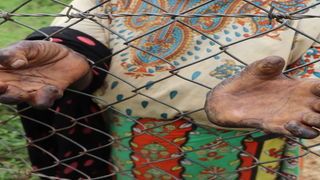
Mwanaulu Ali Pate shows her deformed hands during an interview at Tumbe Village in Kwale County on August 2, 2023. Although she is healed of leprosy, she explains that one of the challenges she faces is getting food and cooking because her fingers are affected by the disease.
It's a dog's life for leprosy survivors in Kwale
Had it not been for a hospital set up for leprosy patients some 60 years ago, Nyawa wa Pihu would have been stigmatised in his village of Mwaluvamba in Kwale's Kinango Sub-County.
But he lives in a ‘leper colony’ in Tumbe village that was set up for lepers in the Msambweni area. It’s a lesser evil.
The colony is now part of the Msambweni campus of the Kenya Medical Training College (KMTC).
The Nation found Pihu in a thatched house, sitting on the dusty mud floor.
He picks up one of his crutches and gets up to sit outside, as the two-room house is barely big enough for three people.
He uses one crutch because he has to balance on both feet; the toes are deformed as a result of leprosy.
Once outside, he sits on the floor again.
"There is no need for me to find a chair and sit on it. Look at my clothes, they are already dirty. They are also my work clothes," he says.
He is one of more than 42 families who live in Tumbe village, a ‘leper colony' in Msambweni sub-county.
Tumbe in Swahili means to despise, isolate or cast out. This is the case with these cured lepers who have been isolated in this village for decades.
The lonely village has scattered, almost similar, semi-permanent houses thatched with grass. The village has one communal toilet and bathroom built by a good Samaritan.
The physical disabilities associated with the disease have left most of the locals.
They now spend their days in Ukunda town, the largest urban centre in Kwale County, where they either walk or crawl to beg for food and money.
They also rely on food donations from well-wishers, but these are few and far between at the moment due to the difficult economic situation.

Nyawa wa Pihu stands outside his house that was damaged by strong winds during the rainy season in June. He is struggling to rebuild it and says he only needs an extra Sh1,000 to pay a mason to finish the job.
On this particular day, Pihu had to stay home because he had been told they were going to have visitors.
"Visitors are a blessing. I stayed because I knew I would get a chance to be heard and some of my challenges addressed," he says.
He admits that he has no other work because he is illiterate and does not have the physical ability to do skilled work.
Every morning he walks from his house to the road and hops into a tuk-tuk that drops him off near the Diani police station, about 20km from Tumbe.
He then waits for a well-wisher to drop a coin or leave a packet of flour.
"On a good day, I usually earn Sh300, which I take home and share with us and the children. Some days I come home with nothing," Pihu explains.
He is currently living in a neighbour's house after his house was destroyed by strong winds during the rainy season in June.
He is struggling to rebuild it and says he only needs an extra Sh1,000 to pay a mason to finish the job.
Just next door, Mwanaulu Ali Pate's story is no different. She lives a lonely life in the quiet village, and by day most of her neighbours have gone to beg in Mombasa or Ukunda towns.
She and her brother were taken by their father to the then-medical centre in Msambweni.

Nyawa wa Pihu uses one crutch because he has to balance on both feet; the toes are deformed as a result of leprosy. He admits that he has no other work because he is illiterate and does not have the physical ability to do skilled work.
She cannot remember the exact year but says it was during the administration of former president the late Jomo Kenyatta.
Their house, built by a well-wisher, is also full of cracks.
"We had first tried traditional medicine, but it was unsuccessful. The situation worsened because people in the village, back in Dzombo in Lunga Lunga sub-county, ran away from us because of the stigma," she explains.
She says that after being treated at the centre, they were asked to set up their houses and start living in the camp to avoid the stigma at home.
They planted trees and started farming. Her life there included starting a family.
"I gave birth to seven children, unfortunately, four did not survive and now only three are alive," she says.
She explains that one of the challenges she faces is getting food and cooking because her fingers are affected by the disease.
"They keep making new wounds when I cook and burn myself. Unlike other women in the area, I can't walk long distances, can hardly wash clothes or even cook viazi karai (fried potatoes) or mahamri (doughnuts) to sell like other women," she laments.
Although she has three children, they rarely go to school because of the stigma they face from other students and are unable to help her financially.
She believes that the hand of a well-wisher to help her set up a chicken-rearing business in her home would go a long way.
"If I can get a person to help me raise free-range chicken that has a ready market in Ukunda and Mombasa, it will change my life completely," she said.

Part of a ‘leper colony’ in Kwale's Tumbe village. Tumbe in Swahili means to despise, isolate or cast out. This is the case with these cured lepers who have been isolated in this village for decades.
Ms Pato's life has now turned into that of a squatter and she believes they may be evicted from the village.
Jimmy Charo, who is visually impaired but helps most of the cured lepers, said the fencing around their camp has become a bigger threat to their lives.
"It is harder now to have well-wishers to come and give us food from time to time. Because we are in an institution and we have to abide by their rules where they do not allow vehicles to enter the compound where our houses are," he said.
He added that most of them find it difficult to get out through the main gate of the institution, which is about 15 minutes away.
For now, their lives as lepers will have to continue, still in isolation, waiting for someone to help them.
They have also asked the new government to recognise them as a special group and provide them with financial and material support, such as wheelchairs.
They also appealed for psychological support, as some have turned to alcoholism as a form of consolation.
According to the World Health Organization (WHO), leprosy, also known as Hansen's disease, is a chronic infectious disease caused by Mycobacterium leprae.

Jimmy Charo (left) , converses with Nyamawi Chale outside his house at Tumbe Village on August 2, 2023. Chale moved from Kinango to Msambweni to be treated, but he now begs on the streets to fend for himself.
It affects the skin, peripheral nerves, mucous membranes of the upper respiratory tract and eyes.
Survivors of the disease have visibly deformed body parts such as toes and nails.
In 1989, leprosy was declared eliminated from Kenya after the country recorded less than one case per 10,000 people, according to WHO standards.
But new cases continue to be recorded in the country. In 2021, 78 new cases of leprosy were reported, with 1,472 cases per 1,000,000 people, according to data from the World Health Organization (WHO) website.
According to the National Tuberculosis and Lung Disease Programme, the number of leprosy cases in Kenya fell from 6,558 to 120 in 2022.
The data shows that 76 cases were male and 44 were female.
Apart from the Coast region, leprosy has also been reported among residents of the Western region and other lowland areas such as South Nyanza.
Dr Obura Michael, a clinician in Busia County, said leprosy was no longer a public health problem in Kenya, “but there are some cases that can be traced.”
He added that although the disease can be treated, the scars are long-lasting.
Outside Tumbe village, life goes on as usual: children play on the verandas of their permanent homes, shops are open and schoolchildren move about in uniform.
In contrast, there is no sign of the hopelessly cured lepers living next door.





